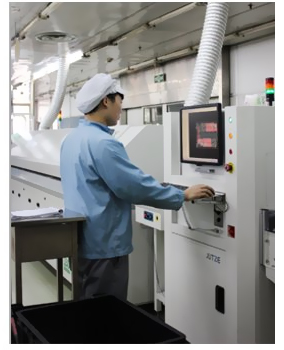AOI

Inspection parameters include checks for component presence, type, polarity, offset, text and solder joint quality for both volume and profile (meniscus) plus the option to inspect the printed solder paste image.
C-Alley develops applications and deploys solutions based on OMRON AOI platforms. The OMRON represents a true inspection innovation by incorporating unique zoom, off-axis and patented color-illumination techniques. AOI reflects Kingsheng’s commitment to providing state-of-the-art and cost-effective test and inspection solutions for today high-technology products.
The Benefits of Automated Optical Inspection (AOI)
Enhanced Precision: As the size of electronic components decreases, the precision of inspection equipment and manufacturing processes becomes increasingly important. AOI systems are designed to have sub-pixel accuracy, ensuring that small deviations in component position, which could result in defects, are detected with sufficient accuracy.
Cost Reduction: AOI testing improves the pass rate of printed circuit boards (PCBs), thereby reducing PCB costs.
Versatile Inspection: AOI tests are not only effective for PCBs but also for PCB assembly. They can detect defects such as shorts, opens, insufficient solder, component soldering, polarity, and values.
Programmable Lighting: Lighting plays a crucial role in achieving desired results in machine vision applications. Due to the constantly changing environment of electronics fabrication, it is impossible to find a single light source that can detect all defect conditions. AOI systems utilize dynamic lighting, configurable within the inspection software, using cost-effective LED technology. This flexibility allows for the broadest coverage of defects by adjusting the lighting angle and color contrast, making it easier to identify various defect conditions.
Network Capable Software: Data collection and retrieval are important functions of any AOI system. AOI systems can collect data in multiple formats, such as text output, image collection, and databases. Retrieving the information may be complex and depend on the specific manufacturing line configuration.
Excellent Flexibility: AOI can be utilized at any stage of the fabrication process based on the specific needs and cost tolerance of the company. Performing AOI testing after reflow soldering is recommended, as most defects result from failures in the soldering process. This reduces associated costs and increases inspection efficiency. Additionally, AOI systems can immediately modify fabrication or assembly parameters to ensure the correct production of subsequent products.
Why is AOI Testing Important?
AOI serves as a quality gate for PCB fabrication, ensuring high-quality production by detecting and correcting fabrication or manufacturing defects in the process flow. With the increasing complexity of PCBs and the critical role they play in electronic products, AOI is crucial for maintaining accurate and reliable designs.
The Importance of Early Detection:
Early detection of faults during the manufacturing process is essential for cost-effectively avoiding larger-scale problems. AOI enables prompt identification of defects, saving time and resources by preventing the replication of issues.
In summary, AOI is a necessary tool for PCB suppliers. It offers the ability to identify surface and dimension defects, detect wrong components or their placement, and verify correct soldering and circuitry. AOI significantly improves PCB manufacturing efficiency, reduces costs, and enhances product quality.

